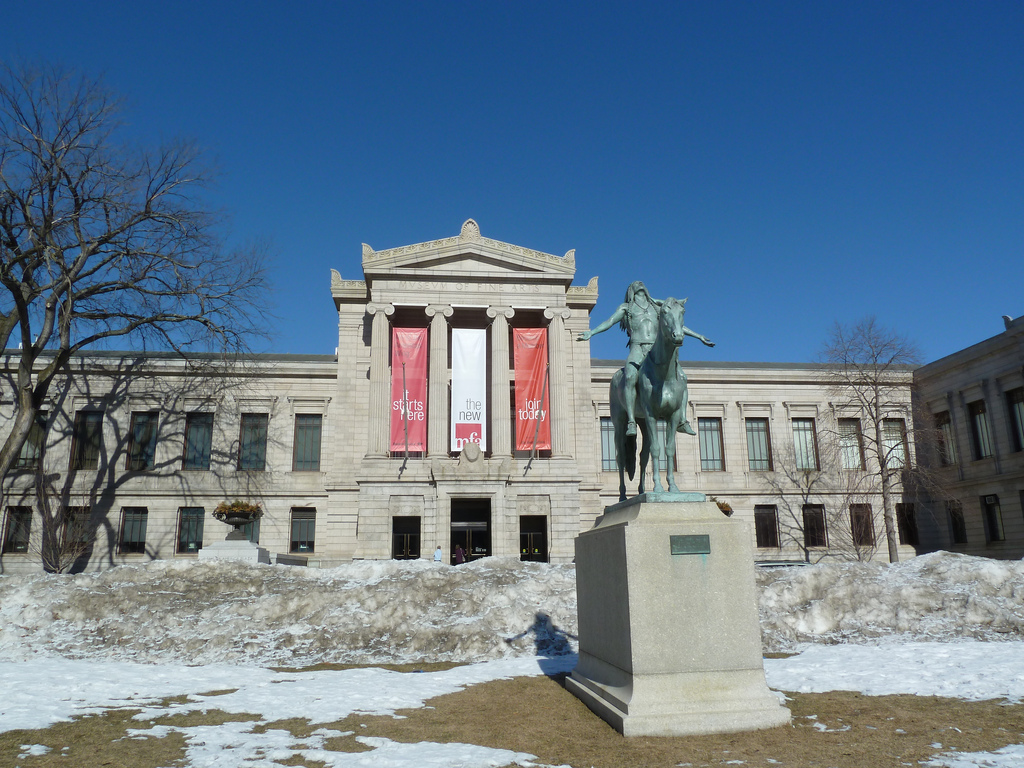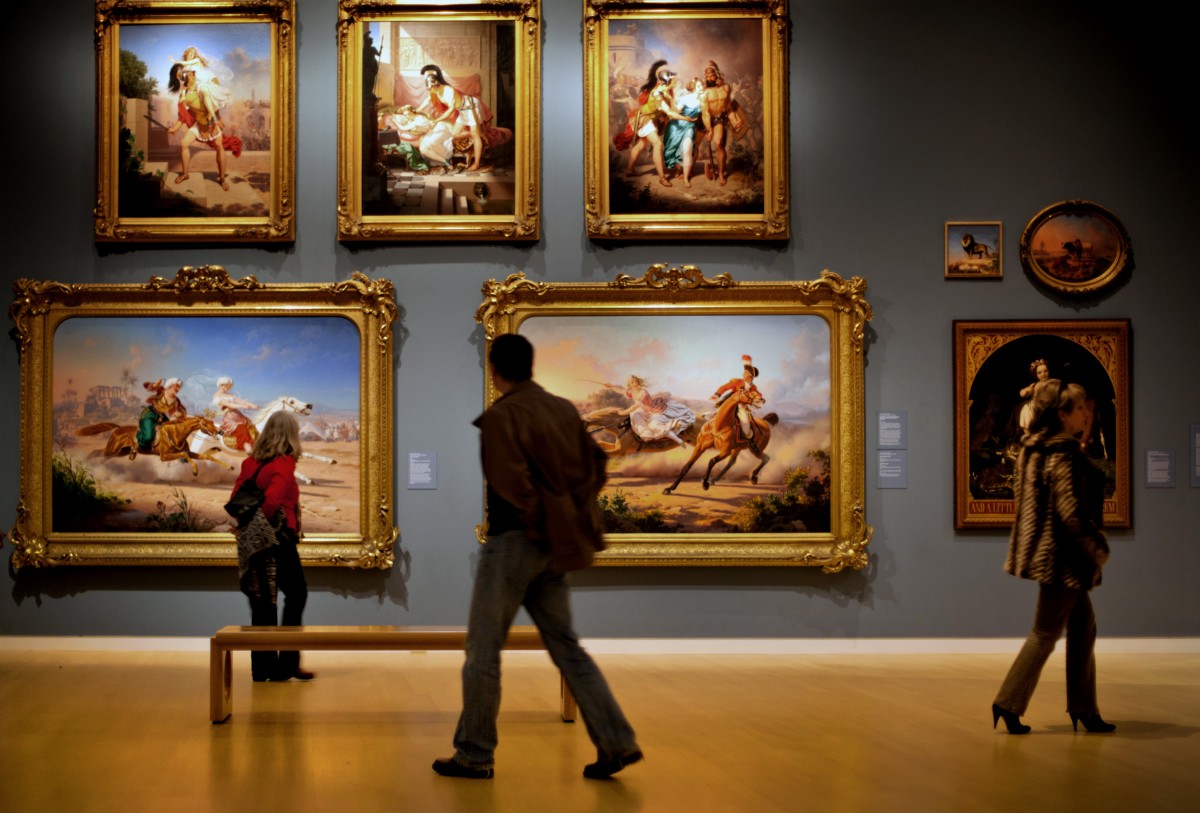White art museum visitors look at a wall of art depicting white historical subjects at a museum in Sacramento, California.
Two Spanish girls from Harlem look at me with curious gazes, tilting their heads as if to study me as I study them. Dressed in knee-length pinafores, one older than the other but not by more than a few years, they are young, black, and beautiful. I pretend to be nonplussed by their presence here, because I want to believe this happens often. I want to believe that it’s completely ordinary for a black person to encounter portraits of black people, but I know that’s not true. Secretly, I am surprised — delighted, even — to see black girls on the walls of Boston’s Museum of Fine Arts.
Art in the Western world tends to be a very white affair. Traditional museums are full of white walls displaying portraits of white subjects, painted by white artists, attracting white visitors. Indeed, the vast majority of canonical artwork produced before the 20th century were created by white men. And when the inequalities that caused this overrepresentation are still very much with us, change can be illusive. Artists and museums, though, are aware of these historical and contemporary discrepancies, and they are taking steps to show audiences how they deal with this tension.
“Monuments to Us,” an exhibition that opened this January at Boston’s Museum of Fine Arts, displays art reflecting the personal histories of people and groups who are often downtrodden or forgotten. Asking, “whose stories are memorialized, and whose are erased?” curator Liz Munsell gathers artwork that questions “the power of artists to make history.”
Alice Neel painted Two Spanish Girls in Harlem in 1959. It’s one of two portraits by her currently on display at the MFA; both are highly intimate. Paying tribute to those she knew well, Neel’s subjects sit in either ambiguous space or their home environments, forcing us to imagine them as beings with full lives of which we access only a moment.
In memorializing those who go unsung, the exhibition presents artwork as an act of subversive remembrance. That project is all the more relevant given recent protests across the world against monuments that honor oppression, from statues of Robert E. Lee which idealize the Confederacy in America’s southern states to ones commemorating Cecil Rhodes, a symbol of British colonialism. Munsell invites us to explore not only who we remember but also how we remember them.

Statues like this one of Robert E. Lee in Charlottesville, VA have sparked controversy over memorialization and representation of controversial historical figures.
Tensions of Representation
The importance of uplifting marginalized groups through representation, though, can be complicated by tensions around who is entitled to produce this kind of artwork. John Ahearn and Rigoberto Torres’ papîer-maché sculptures are literal monuments to marginalized friends and neighbors. Together, they worked on multiple public art projects — one was displayed on 42nd Street, and another was placed on Walton Avenue to create a South Bronx Hall of Fame. Critics at the time of Ahearn’s ascent were concerned with the right he had as a white artist to represent non-white people. Ahearn, though, continues to defend his approach; in an interview with the HPR, he noted that “art embraces contradiction.” He added that his move to the Bronx was precipitated by a boredom with the downtown, mostly white, bohemian art scene: “The Bronx neighborhoods were family-oriented people of color … I believe that my efforts working in the Bronx [produced] wonderful artwork.” To Ahearn’s credit, he took steps to include his subjects in the artistic process — not many know that for each cast he created, he gave another to the subject to keep in their home.

The Highbridge Neighborhood in the South Bronx, where Torres and Ahearn worked as artistic partners during the early years of their careers.
Torres met Ahearn when he was 17 years old, and convinced him to move to the Bronx in 1980. Torres and Ahearn became artistic partners, though their careers took different paths after 1992. After the end of the 42nd Street Project, Torres suffered an asthma attack which put him in a coma and rendered him blind for a number of years. His gallery dropped him, and over the course of the next decade, he had to learn how to make art all over again. Torres now only has one major collector, despite the fact that he was Ahearn’s partner for almost a decade and that he continues to make art very similar to Ahearn’s in style. In an interview with the HPR, Torres explained the barriers he’s faced in his career: “I am an artist, but I am also disabled, so it has been difficult for me.”
However, Torres continues to see his relationship with Ahearn as complementary and not exploitative. For his part, Torres serves as a sort of bridge between Ahearn and the Bronx community. “When I am around,” he explained, “it makes it easier for [Ahearn] to work in a neighbourhood that is mixed.” But Torres sees Ahearn’s role in the art world as critical, too, mentioning that Ahearn asked his gallery to pay Torres’ shipping costs for a recent exhibition: “Without him, I don’t think [my work] would be going on.” Indeed, the art world can aid artists as much as it can replicate the structures that hold them back.
Sculptures like the ones Ahearn makes are just one type of monument to the marginalized. Work like Ahearn’s requires an individual to stand in as a representative of an oppressed group. Groups are oppressed, not individuals, but oppression is experienced by individual agents. Responding to this complicated social fact in a figurative way shows that individual experience, but often ignores the complexities of the collective one.
Only two conceptual works hang in “Monuments to Us”: Now, Speak!, a concrete lectern by the Argentinian artist Amalia Pica, asks attendees to read speeches by people of different identities, while Facts, Which If True (Joe McCarthy) by Donald Moffett honors victims of the 1980s AIDS crisis. A ring of individual roses forms crossed fingers which signal good luck, representing the bittersweet mix of hope and paranoia that consumed entire communities, and the political climate which made many queer people and people of color invisible. Disembodied but still emotional, this kind of art requires viewers to stop and think about the feelings, concerns, and pressures that entire marginalized groups deal with in a way that a single portrait cannot.
David Hammons’ In the Hood (1993) exemplifies the power of conceptual art. Cut from a green sweatshirt and pinned to a gallery wall, a hood hangs as if it’s being worn. The simplicity of the piece lends itself to a variety of conversations relevant at the time of its creation: how rap culture influences fashion, how teenagers signify social class, how the Ku Klux Klan invoked fear, and how black men are perceived as threatening. This work remains relevant in a country where children in sweatshirts can be killed with impunity because being black, male, and wearing hoods sufficiently terrorizes whiteness. Claudia Rankine connected Hammons’ work to the issue of police brutality when she used In the Hood on the cover of Citizen: An American Lyric, a groundbreaking book on being black in America.
The Museum as a Political Space
If “Monuments to Us” is unique because it provides a space for art representing “lives and experiences of groups that have been systematically excluded,” we are forced to ask why museums like the MFA fail to include this sort of art ordinarily. “Monuments to Us” explores hefty themes, but the exhibit itself features 10 works of art and is located in a room next to the exit through the gift shop, meaning that viewers can easily walk through without stopping. In a museum as big as the MFA, that such a politically engaged show retains so little space is disconcerting, but that it exists at all is a source of optimism.

The Museum of Fine Arts in Boston, Massachusetts, home to the “Monuments to Us” exhibit.
While “Monuments to Us” represents the change that can come from within an institution, other museums have had to respond to external criticism of their role in over-representing whiteness, both in the art they display and the staff they hire. The Black Power era, from 1968 to the late ‘70s, was a particularly contentious time in American society, and this atmosphere extended to the art world where major changes were provoked by activism. An ongoing exhibition at the Whitney Museum of American Art, “An Incomplete History of Protest: Selections from the Whitney’s Collection, 1940–2017,” shows correspondence between the museum and the Black Emergency Cultural Coalition, a group of artist-activists who demanded that the Whitney show more black art in its biennial during the 1970s.
For two years, the BECC held meetings with Whitney staff, and as a result the museum’s chief curator commissioned a show called “Contemporary Black Art in America.” However, when demands for a black curator were unmet, one in five artists boycotted the show. One such artist, Eldzier Cortor, explained his dissatisfaction in a letter: “I cannot in full conscience enter my work into the Whitney exhibition until [the BECC’s] list of grievances are resolved.”
Female artists have also played a critical role in the movement for a more intersectional, diverse art world. A group of women called AdHoc demanded in 1970 that 50 percent of artists in the upcoming biennial be women, and that exhibitions “reflect the ethnic distribution of the metropolitan area in which the show is being given.” The impact, while not revolutionary, was notable: Caroline Wallace reports that “the 1969 Whitney Painting Biennial had less than 5 percent women artists — only eight artists of a total of 143. The 1970 Sculpture Biennial fell short of the 50 percent gender balance demanded by Ad Hoc but did show a considerable shift, to 22 percent.”
By inserting themselves into art history, black and female artists ensure not only that they will be remembered as creators and thinkers, but also that the art available in the public sphere reflects shifts in social values. Their acts touch on one of the defining features of the relationship between art and power — all exhibitions, even if unintentionally, offer arguments within political contexts. Collectors, curators, and foundations, furthermore, play a key role in informing the version of truth that is advanced through art.
Exclusion, misremembrance, and exploitation are all the more likely when a homogenous group controls the production of meaning and significance in the art world, whether they are conscious of their effects or not. Today, the fault lines between contrasting views on how oppressed groups are and should be remembered by artists and institutions still provoke protest. Artists grappling with how oppressive legacies affect our present, and how that history should be acknowledged and commemorated, face a difficult project, but also possess the power to shape our society’s understanding of where we come from and where we are going.
Image Credit: Pxhere // Wikimedia Commons/Cville Dog // Flickr/Ken Lund // Flickr/Richard Howe
